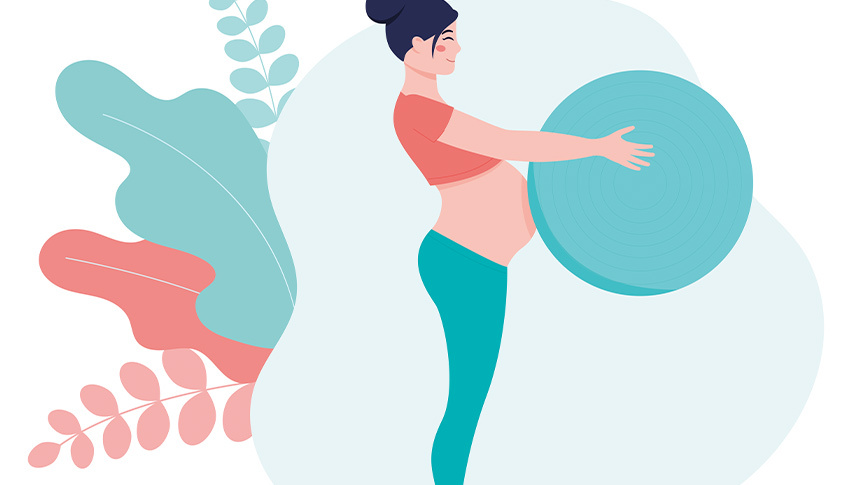Does Pregnancy Cause Split Abs? What You Need to Know

When you’re pregnant, there are certain changes you expect. Maybe your feet will swell, or you’ll get strange cravings. Nausea happens to many but passes around the 16th week. A lot of these come up in ‘what to expect’ books, or we are gently told about them from our friends and family. But somehow, split abs seem to be left off the list of ‘weird things our bodies do during pregnancy’.
Yes, you heard us right—ab splitting. Your mind might be conjuring up something from Alien, but it’s not quite that dramatic. However, splitting abdominal muscles (diastasis recti) toward the end of or after pregnancy is something you need to know about!
What Is Diastis Recti?
Diastasis recti is what we call the thinning and widening of your abdominal muscles—this thinning develops as your stomach expands in the later stages of pregnancy. This change to your body to accommodate the baby is normal, but it can cause the right and left sides of your ‘six pack’ abs (also called the rectus abdominis muscle) to separate below the skin.
You may notice this as an indentation or a bulge in the middle of your belly, but it can also be accompanied by lower back pain, difficulty maintaining good posture, and constipation and bloating.
Diastasis recti is very common; it happens to roughly half of pregnant people but is more common if you are having multiples, have had recurrent abdominal surgery (like a C-section), or have had more than one pregnancy.
In rare cases, the separation can be so bad it causes a hernia, which is when organs poke through the separated abs and push against the skin.
Can You Prevent Ab Splitting During Pregnancy?
You may not be able to prevent diastasis recti, but you can do some things to reduce its severity. You already know that it’s important to avoid lifting heavy objects while pregnant, but you should also make sure your back is well supported while sitting, and that you maintain good posture.
If you already have strong abs, they will be less likely to separate. However, if you are already pregnant, there are some exercises that are okay, and some that are not. Your doctor should be able to advise core exercises that are safe to do while pregnant.
What If I Already Have Split Abs From Pregnancy?
Split abs may recover on their own. It’s important to remember not to ‘push’ your abs so that the split becomes larger, and avoid uncomfortable activities. That includes any strenuous exercises where your ab muscles are bulging out, holding a baby on one hip (if it hurts) or lifting heavy items.
If you have split abs and want to help recovery, avoid traditional crunches, situps, and planks postpartum until your abdomen is healed. These exercises can make the condition worse. Look into leg extensions as a way to recover safely from split abs, but talk to your doctor first!
You may want to use a support item like wraps or binders, which may help in a way similar to wrapping a rolled ankle. But, be careful. When bound too tightly, postpartum wraps can actually worsen your core by putting more pressure on the pelvic floor.
As you know, your pelvic floor will be weakened by pregnancy and struggles to function when your abs are weak. Going to a pelvic floor physical therapist, or physiotherapist can help give you the tools you need to help heal your pelvic floor.
You can also incorporate healing into your daily life by practicing good posture, using lower back support, and rolling to the side when you’re sitting up, or getting in/out of bed.
Facts Checked By:

Dr. Shree Datta is a Consultant Obstetrician and Gynaecologist in London, specialising in women’s health including all menstrual problems such as fibroids and endometriosis. Dr. Shree is a keen advocate for patient choice, having written numerous articles and books to promote patient and clinician information. Her vision resonates with INTIMINA, with the common goals of demystifying periods and delivering the best possible care to her patients.
Article written by:

Dr. Shree Datta is a Consultant Obstetrician and Gynaecologist in London, specialising in women’s health including all menstrual problems such as fibroids and endometriosis. Dr. Shree is a keen advocate for patient choice, having written numerous articles and books to promote patient and clinician information. Her vision resonates with INTIMINA, with the common goals of demystifying periods and delivering the best possible care to her patients.
Article written by:

Lane Baumeister is an internationally-based Canadian writer with several years’ experience creating educational and entertaining articles that discuss intimate health and sexual well-being. When not waxing profound about menstruation, she devotes herself to enjoying extremely good food and equally bad movies.


